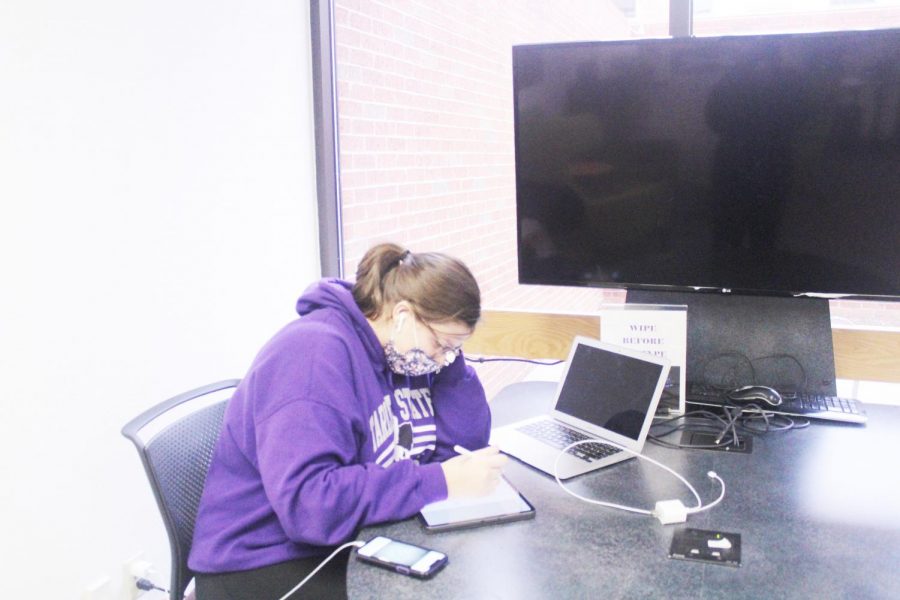Tarleton adjusts Hyflex model
Allison Dycus knocking out homework in the lower level of the library on Jan. 22, 2021.
Universities across the nation have been working tirelessly to find a successful method of online learning during the pandemic, and Tarleton State University is no different. As we learn more about COVID-19, we learn more about how to educate students during a pandemic.
This semester, Tarleton’s Academic Administration has made some changes to the previous Hyflex model used during the fall 2020 semester. The main change being the removal of asynchronous classes. While this was a disappointing change for many students, its removal is intended to benefit students.
Dr. Jordan Barkley, the Associate Provost and Associate Vice President for Academic Administration explained that the student instructor evaluations were the main reason for removing the asynchronous aspect from the Hyflex model.
“We collected student evaluations of instructor feedback and came to the realization that students, when left to their own devices, reported that they had trouble keeping up with class and meeting deadlines,” Barkley said.
Barkley also mentioned evaluations from students involved in recent suspension hearings. He explains that the honesty of some of these students backed up their decision to remove asynchronous class.
“We just concluded our suspension hearings and we received feedback there from students who were honest and said ‘hey look I thought I could do this asynchronously and watch the lectures’ but they were not.
“We just don’t want to set students up to believe they can complete a course erroneously without ever having interacted with faculty or the course itself on canvas,” Barkley said.
Canvas data also played a big role in determining the success of the asynchronous model. Barkley explained that the Canvas data was analyzed and it showed that the students that chose to participate asynchronously rarely watched the recorded zoom lessons.
“We also have the ability to look at canvas and see how active a student was in the course. It was very telling, we had students that were not showing up for face-to-face, synchronously via zoom and they also weren’t accessing the recorded class lectures,” Barkley said.
Asynchronous is still an option if you meet the criteria. For example, if you are too sick to attend face-to-face, zoom class or you have a university sponsored event to attend you can reach out to your instructor to discuss an asynchronous option.
“For the spring semester, in order for a student to take advantage of remote asynchronous learning, instructor approval is now required. Instructors will be evaluating requests based on if the student had a COVID-19 related issue, are they too sick to join the zoom and are they part of a university sponsored event such as rodeo, football or basketball. Since a lot of sports got moved to the spring semester, those students traveling for university sponsored events can’t log into class at a specific time,” Barkley said.
Removing the asynchronous style is one of the ways Barkley hopes to encourage interactions for students with their instructors and the course content. He also hopes that this change will help guide Tarleton Academic Administration in finding more ways to enhance the students academic experience.
“We are not trying to force face-to-face interactions with students and faculty. But we know that students tend to do much better in the class if they have interactions with their professors, even via zoom. This is just one of the ways we’re trying to encourage students to interact with faculty and class content more often,” Barkley said.
Even though we’re in a pandemic, students deserve to receive the education they’ve paid for. The challenge is doing that safely. Barkley’s excitement to improve the Hyflex model is encouraging. He explains that although there is always room for improvement, some situations are difficult to predict.
“We’re always looking for ways to improve. We have trained an army of faculty to give resources for each college. So, it’s not like we haven’t done enough but I’m anxious to see, after we start to learn more about Hyflex models, how they can enhance the education a student gets,” Barkley said.
Another change that is being made involves hands on classes such as construction management, ranch management, labs or welding. Barkley explains how classes like these are nearly impossible to complete online.
“Imagine taking a welding class online. There is only so much you can do without physically being there in class. We have approved quite a few face-to-face courses, most of which are labs, but even in these cases we’ve talked with faculty and required structuring these courses in a safe manner,” Barkley said.
While there are few big changes to the Hyflex model this semester, you can expect main things to remain the same. Face masks and social distancing are still required and the instructor must keep the classroom at 50 percent capacity.
As we continue to learn more about the COVID-19 pandemic, be prepared to see changes. This is a learning experience for all of us. If you have any question or would like to stay up to date with Tarleton’s academic plan, you can visit web.tarleton.edu/roadmap/.



